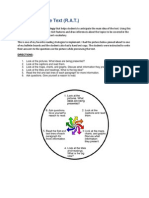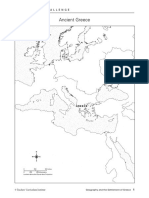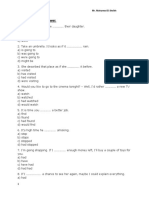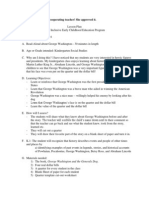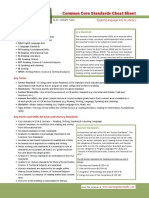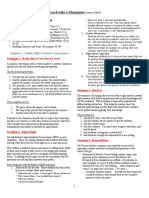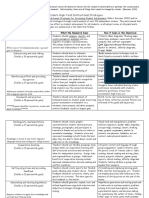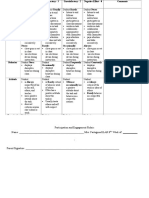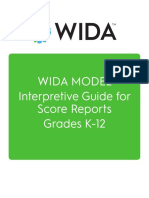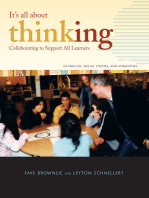6ELA StudySync PlanningandCoachingGuide
6ELA StudySync PlanningandCoachingGuide
Uploaded by
mariah felixCopyright:
Available Formats
6ELA StudySync PlanningandCoachingGuide
6ELA StudySync PlanningandCoachingGuide
Uploaded by
mariah felixOriginal Title
Copyright
Available Formats
Share this document
Did you find this document useful?
Is this content inappropriate?
Copyright:
Available Formats
6ELA StudySync PlanningandCoachingGuide
6ELA StudySync PlanningandCoachingGuide
Uploaded by
mariah felixCopyright:
Available Formats
1
Creighton School District
Curriculum and Instruction 2016
StudySync Planning and Coaching Guide
Creighton School District, 2016
2
StudySync Planning and Coaching Guide
The purpose of this document is to guide Instructional Coaches in providing teachers with additional information about StudySync.
Beyond the training, teachers may have questions and concerns with how to effectively implement this new curriculum in their
classrooms. This document provides tips, clarification, reviews potential questions and answers, challenges that might surface and
their possible solutions.
Teacher Helpful Hints/Creighton Unit Guides
● There will be suggestions in the publisher’s pacing guide where students are asked to compare their Full Text Study chapter
to a text that was either taught in a previous grade level or to a text that is not available on StudySync. Teachers can either
access the text through the grade level link on StudySync, search the text online, or elect to skip the comparison lesson if the
text is not available or if time does not allow.
● “Link” in Instructional Path (Creighton Unit Guide) is from the column “Connecting Full Text to Instructional Path” for
particular day in Pacing Guide (StudySync)
● For each First Read, the StudySync Teacher Resource Companion (spiral) offers Scaffold Instruction to Access Complex Text
and ACT Features to help students with comprehension. This information is also included in the First Read Lesson Plans on
StudySync in the Overview Section under Access Complex Text.
● When planning with team and/or coach refer to Response to Intervention/SPED doc for first steps in assessing students and
applying modifications, accommodations and interventions for any students showing difficulties.
● If time becomes an issue the “Link” should be the first component to be eliminated from the plan. If time is continuing to be
an issue the “compare task” from the Full-text study should be the next component to be eliminated. (With practice and
consistency students should become more efficient with lessons tasks and these components need to be returned to plan)
● It is advised to review all lesson components before instruction. Also, as a team along with your Coach read the User Guide
(pg. iv-xxix) of the Teacher Resource Companion to ensure you know and understand all aspects of StudySync.
● District assessments will consist of a pre/post test, 4 mid-unit assessments and 2 IBM’s. In addition to district assessment
teachers should also use their own formative assessments. E-Assessment is available for teacher use to create assessments,
rubrics and tests that are aligned with all instruction. E-Assessment contains questions from 3 major sources: Partnership for
Creighton School District, 2016
3
Assessment of Readiness for College and Careers (PARCC), Smarter Balanced Assessment Consortium (SBAC) which are
AzMerit Style questions, and McGraw Hill Education (MHE).
Instructional Coach Helpful Hints
● Stuck on navigating StudySync? Not a problem! Log in to ConnectEd. On the “Launch” page to the left, there is a link that
says, “Professional Development.” Once clicked, it will prompt you to enter the PD page. Once you open this page, there are
hundreds of videos that are available for teachers to watch to help them with program navigation. There is also the
availability for you to provide teachers with a “Certificate of Completion” if your use of this page warrants PD hours. Answer
to your question not there? Check out Youtube!
● For the Research Project, the Extended Writing Project, and the Full Text Study, coaches and teachers should work together
to map out the pacing of the lessons to best suit the needs of their students. The total number of minutes/days for these
projects are listed in the “Notes” section of the Unit Guides.
● For Speaking and Listening Lessons, it is important to help teachers plan and deliver the lessons so that their students have
the skills necessary for the coming discussions or projects.
● Guide teachers at the first planning meeting to create the rubric for mid-unit assessments (instructions attached to all 6-8
Unit 1 Mid-Unit Assessment TAGs). Make a note of how to prepare students to answer all of the Think Questions: AQE
(Answer, quote, explain) is a great way to summarize and instruct students to score full points on all Think questions. The
rubric language is as follows:
○ Score 3: The student answers all parts of the question correctly AND chooses strong and relevant evidence that
supports the correct answer and elaborates AND explains how the evidence supports the correct answer.
○ Score 2: The student answers all parts of the question correctly AND chooses strong and relevant evidence that
supports the correct answer but DOES NOT elaborate and explain how the evidence supports the correct answer.
○ Score 1: The student answers all parts of the question correctly but DOES NOT choose strong and relevant evidence
that supports that answer and DOES NOT elaborate and explain how the evidence supports the correct answer.
Creighton School District, 2016
4
StudySync Q&A
1. What is the difference between a key standard and a practice standard?
○ Key Standard - explicitly taught; goal is mastery
○ Practice Standard - not explicitly taught (during given lesson); spiraled throughout unit; mastery is not goal
2. Why are there so many Key Standards in each unit part?
○ When looking over the key standards covered in each unit, it does seem overwhelming but keep in mind that these key
standards are covered over the course of at least 40 days! When examining each lesson, you will find that only a few
key standards are focused on and practiced.
3. Why would students practice a standard before I teach it explicitly?
○ The practice standards are introduced at a low level of rigor, making them easy to understand and apply within an
informal task. This progression is to assist in student understanding by establishing a routine and foundation of the
concept.
4. Why are there standards that are assessed in a quarter that are not taught as key standards during that quarter?
○ The standards on which students are assessed on the Mid-Unit District Common Assessments (DCA) were selected
based on whether or not they had been explicitly taught at some point in the year prior to the administration of the
DCA. The Curriculum Cabinet Committee was also careful to select standards that are practiced by students on a
routine basis, specifically in the First Read lessons.
5. How were the suggested minutes on the Unit Guides determined and by whom?
○ The suggested minutes for Blasts, Skills, First Reads, Close Reads, and the different parts of the EWP were determined
by StudySync. Minutes for all other activities were determined by the 6-8 ELA curriculum cabinet after practicing the
units. Some activities are labeled TD for teacher discretion. For these activities, each teacher can determine how much
time they want to allocate for those activities. For example, Full Text Study chapters are labeled TD because teachers
can determine how they want their students to read each chapter (ex: independent silent reading, read alouds, etc.).
The time needed to complete each Full Text Study activity will vary depending upon the reading method the teacher
wants to utilize. Please remember that the minutes are suggested.
6. There are some days where the suggested minutes exceed the number of minutes that I have to teach one class; how should
I overcome this challenge?
Creighton School District, 2016
5
○ This is why TD, teacher discretion, was put into the unit guides. Use your best judgment to determine what your class
needs the most support in and focus on that activity. You can shorten the amount of time given to the EWP or
Research Project for that day. Some days will not have as many suggested minutes as others. If you plan ahead, you
may be able to complete some activities scheduled for other days during those days with fewer suggested minutes.
7. There are days where the suggested minutes are incredibly short, sometimes 30 minutes or fewer. What should I do in these
cases?
○ In cases like this, consider diving into the Extended Activities. These Extended Activities can be found in each lesson
plan. If time still allows, try jumping into one of the Additional Resources provided at the bottom of the StudySync
homepage. The Vocabulary Power Workbook (6th, 7th, 8th) and the Spelling Power Workbook (6th, 7th, 8th) are great
resources that align with the concepts and standards covered in each lesson.
8. Where did the Unit Overview information come from, such as the Unit Goals, Big Idea, and Essential Question?
○ After reviewing the StudySync materials, teachers were put to the task of summarizing their findings. You will find that
many of our Unit Goals, Big Ideas, and Essential Questions come directly from the Overview section found at the
beginning of each unit.
9. The StudySync Pacing Guides are all 45 days long but we never have a full 45 days of instruction in a quarter. What is a
proposed solution for this problem?
○ It is suggested to review the Instructional Path, Unit Guides, and Lessons before beginning a unit/lesson. Depending on
time (assemblies, early release, and schedule changes) and student abilities, lessons should be combined to ensure all
instruction is delivered throughout the quarter.
10. I want to differentiate my subgroups, is there a way to have my students access the same text at their appropriate
instructional reading level?
○ Absolutely. StudySync provides three different Lexile Levels for all texts accessible to students. In order to make
differentiation easy throughout the school year, it is important to identify the levels of your students (see the
Diagnostic Handbook on the main Core ELA page for your grade level) and place them in Target groups based on their
level. Then, when you assign students tasks through StudySync, you’ll be able to easily assign each group their own
appropriately leveled text.
Creighton School District, 2016
6
11. On the main page for each grade level, I see that there are multiple handbooks for students and teachers. Do I need to print
those for my students?
○ No. All assessments and handbooks will be accessible to students through their online accounts.
12. Will there be a benchmark writing assessment?
○
Predicted Challenges and Possible Solutions
Predicted Challenges Possible Solutions
● Not able to get through content ● Consider eliminating the “Link” followed by the
“Compare Task” from the Full-Text Study.
● Novel is too difficult for students ● If the novel is too difficult, read together or in small
groups. Review vocabulary and explain foreign concepts.
● Teacher overwhelmed with the multiple components of
● Practice makes perfect! Continue practicing your pacing
StudySync
and reflect on how the curriculum fit the needs of your
students. Prepare teachers for the realization that the
Instructional Path and StudySync activities are going to
be rigorous. Encourage teachers to focus on one activity
at a time, such as a Blast Activity. Have them become
● Making the decision to “cut” something from the pacing experts in the pacing and instruction associated with
guide each task.
● This is an important decision. Be sure to consult Coach
to ensure that all instruction is delivered in its entirety.
(Before anything is considered to be eliminated,
● Teachers proposing to teach alternative texts remember, to maintain fidelity to the core all
components need to be taught)
● With our first year of implementing StudySync, teachers
Creighton School District, 2016
7
may want to deviate from the Full-Text Studies and insist
on completing a novel or reading activity they are
familiar with. Encourage teachers to stay true to the
StudySync curriculum for the sake of fidelity and
consistency with the district. If the teacher persists with
● Management of ELA Block (whole group, small group, the idea of using an alternative text, have them align the
individual) novel or activity to the curriculum and standards to
ensure students are still exposed to the concepts.
● There are many ways to manage the ELA block. Most
instruction can be delivered using whole group
instruction, however guided reading groups and
● Access Paths not appropriate and accessible for literature groups can be used to teach isolated skills and
student(s) leveled instruction. Center based instruction may be
considered to ensure instruction of all students.
Checklist of activities for students not participating in
guided groups help to ensure engagement.
● If Access Paths are not appropriate for students,
continue working with the Access Paths, but alter
presentation of materials and pacing to fit student
needs.
Access Paths
● Access Paths 1-3 are appropriate for ELL students (referred to as Beginning, Intermediate, or Advanced).
● Access Path 4 (referred to as Approaching Grade Level or Approaching) is appropriate for students receiving Special
Education and Intervention services and for students who are struggling readers.
● The Access Path handouts are the same for some activities.
● Teachers should preview the Access Path handouts before assigning them to students to determine if it is appropriate for
each student’s needs.
Creighton School District, 2016
8
● The Access Paths are not appropriate for all students. Some students may be lower than Access Path 4 which is for students
approaching grade level, so teachers will need to further differentiate instruction and materials to meet the student’s needs.
For more information about how to assist these students, refer to Response to Intervention/SPED doc.
Help for ELD Teachers
● ELP standards have been pulled from the Stage IV, High Intermediate level, and are aligned to the ACCRS for Reading,
Writing, Language (L1 and L2), and Speaking and Listening.
● There are additional ELP standards in Reading and Writing that will not appear on the Unit Guides but should be taught.
Please work with your Coach to determine the best way to address this by using the State Departments ELP Standards
Glossary and then incorporate them into your instruction. The reason that these standards were not included in the Unit
Guides is because they do not directly align to a particular standard.
● You are not limited to teaching the ELP standard within the quarters in which they are aligned. You can always add the ELP
standards to any quarter, but you cannot eliminate any ELP standards from their existing quarter.
Creighton School District, 2016
You might also like
- Sixth Grade Country ReportDocument13 pagesSixth Grade Country Reportpascarf4429No ratings yet
- Read Around The TextDocument6 pagesRead Around The Textapi-258758965No ratings yet
- Lesson Plan Outline: Understand Know DoDocument4 pagesLesson Plan Outline: Understand Know Doapi-430339218No ratings yet
- One Word ActivityDocument1 pageOne Word Activityapi-238184888No ratings yet
- Teach Like A ChampionDocument6 pagesTeach Like A Championapi-302045862No ratings yet
- Math Binder Check Rubric: NameDocument2 pagesMath Binder Check Rubric: NameanjumrajgoliNo ratings yet
- Paired Passages - PresentationDocument17 pagesPaired Passages - Presentationsuchi ravaliaNo ratings yet
- Lesson Plan For Intervention and Enrichment For Division With Interpreting RemaindersDocument13 pagesLesson Plan For Intervention and Enrichment For Division With Interpreting Remaindersapi-234842570No ratings yet
- Teach Like A Champion 2Document9 pagesTeach Like A Champion 2api-4748417650% (1)
- Aw Isn 25 PDFDocument7 pagesAw Isn 25 PDFmariah felixNo ratings yet
- Front Office Services RubricDocument1 pageFront Office Services RubricAnne MorenoNo ratings yet
- Dorothy J. Donat - Reading Their Way - A Balance of Phonics and Whole Language-Scarecrow Press (2003)Document113 pagesDorothy J. Donat - Reading Their Way - A Balance of Phonics and Whole Language-Scarecrow Press (2003)vishNo ratings yet
- Scoring Guide Move Fast - Fly High - TDDocument4 pagesScoring Guide Move Fast - Fly High - TDAqsa MunirNo ratings yet
- Grammar Practice - ACT English - ACT ReadingDocument12 pagesGrammar Practice - ACT English - ACT ReadingRoaa HanyNo ratings yet
- Teacher Timesavers TemplatesDocument0 pagesTeacher Timesavers TemplatesGreenic525No ratings yet
- Not So Itty Bitty Book of The Cif 2Document85 pagesNot So Itty Bitty Book of The Cif 2api-307100415No ratings yet
- Field Observation 11Document11 pagesField Observation 11api-534825975No ratings yet
- My Student Teaching JournalDocument9 pagesMy Student Teaching Journalapi-209380023No ratings yet
- Webbs DOK GuideDocument13 pagesWebbs DOK GuideNightwing10No ratings yet
- Released 2013 Assessment: Language 2, Writing: Assessment of Reading, Writing and Mathematics: Primary DivisionDocument19 pagesReleased 2013 Assessment: Language 2, Writing: Assessment of Reading, Writing and Mathematics: Primary Divisioncatalin_chirilovNo ratings yet
- Eureka Math Grade 2 Module 1 Parent Tip Sheet 092415Document2 pagesEureka Math Grade 2 Module 1 Parent Tip Sheet 092415api-324573119No ratings yet
- Scope and Sequence High School English 9Document16 pagesScope and Sequence High School English 9Louie Jay Cañada AbarquezNo ratings yet
- Stepping Through Addition and Subtraction Word ProblemsDocument7 pagesStepping Through Addition and Subtraction Word ProblemsMuhammad wasimNo ratings yet
- LP 8th ELA FebruaryDocument32 pagesLP 8th ELA Februarymackies1100% (1)
- Character Traits Observation Lesson WorkwithoutextensionDocument4 pagesCharacter Traits Observation Lesson Workwithoutextensionlbaldw3No ratings yet
- Eureka Math Grade 2 Module 3 Parent Tip Sheet 1Document2 pagesEureka Math Grade 2 Module 3 Parent Tip Sheet 1api-324573119No ratings yet
- Ela Daily Structure PDFDocument32 pagesEla Daily Structure PDFapi-291877361No ratings yet
- Read Aloud Lesson Plan ReflectionDocument9 pagesRead Aloud Lesson Plan Reflectionapi-252458800No ratings yet
- Favorite Lesson PlanDocument8 pagesFavorite Lesson PlanDiyahNo ratings yet
- SIOP Lesson Template Topic, Class, and Level - Which Community Do You Prefer?, Writing, Grade 2Document4 pagesSIOP Lesson Template Topic, Class, and Level - Which Community Do You Prefer?, Writing, Grade 2api-264688073100% (1)
- Common Core Cheat Sheet Learning UnlimitedDocument1 pageCommon Core Cheat Sheet Learning Unlimitedapi-182083489No ratings yet
- 3rd Grade Guided Reading LessonDocument4 pages3rd Grade Guided Reading Lessonapi-543821252100% (1)
- Grab and Go GamesDocument5 pagesGrab and Go GamesTú NguyễnNo ratings yet
- Classroom Assessment: A Practical Guide For EducatorsDocument16 pagesClassroom Assessment: A Practical Guide For EducatorsJonna Marie IbunaNo ratings yet
- Teach Like A Champion Outline-Notes 1Document8 pagesTeach Like A Champion Outline-Notes 1api-329395295100% (2)
- Third Grade - Creating Mental ImagesDocument8 pagesThird Grade - Creating Mental Imagesapi-527684545No ratings yet
- Lesson Plan GuideDocument3 pagesLesson Plan Guideapi-519215375No ratings yet
- Marzano's High-Yield Instructional StrategiesDocument5 pagesMarzano's High-Yield Instructional StrategiesAndy FincherNo ratings yet
- Ela StandardsDocument66 pagesEla Standardsapi-425914224No ratings yet
- Inquiry 5e Lesson Plan TemplateDocument3 pagesInquiry 5e Lesson Plan Templateapi-489465282No ratings yet
- Nonfiction QAR Question StemsDocument2 pagesNonfiction QAR Question Stemsedyoututor100% (3)
- Figurative Language and Poetry Unit Plan For 6 Grade Language ArtsDocument52 pagesFigurative Language and Poetry Unit Plan For 6 Grade Language Artsapi-456703108No ratings yet
- Study Guide Out of The DustDocument22 pagesStudy Guide Out of The Dustapi-328252734No ratings yet
- Participation and Engagement Rubric Oct 3-6Document2 pagesParticipation and Engagement Rubric Oct 3-6esmeralda0385No ratings yet
- Maze #1: © 2009 Savetz PublishingDocument10 pagesMaze #1: © 2009 Savetz PublishingSwaro The GameNo ratings yet
- Opinion Writing Rubric Grade 5Document4 pagesOpinion Writing Rubric Grade 5api-284398568No ratings yet
- 8 Strategies For Teaching Academic Language EdutopiaDocument4 pages8 Strategies For Teaching Academic Language Edutopiaapi-251793284No ratings yet
- WidaDocument20 pagesWidaapi-448096857No ratings yet
- A - Most Up To Date Time SlideshowDocument15 pagesA - Most Up To Date Time Slideshowapi-465726569No ratings yet
- Unit Plan For Opinion Writing 3rd GradeDocument23 pagesUnit Plan For Opinion Writing 3rd Gradeapi-249867232No ratings yet
- Socratic Seminar: Practical Method For Applying The Strategy in The ClassroomDocument10 pagesSocratic Seminar: Practical Method For Applying The Strategy in The ClassroomChristy Bailey McManusNo ratings yet
- Socratic Seminar MaterialsDocument45 pagesSocratic Seminar Materialsapi-373671607No ratings yet
- Grammar SyllabusDocument4 pagesGrammar Syllabusapi-422035003No ratings yet
- Res 5153 PresentationDocument30 pagesRes 5153 Presentationapi-559012719No ratings yet
- Gr6 CalvinandHobbes (1) PowerPointDocument20 pagesGr6 CalvinandHobbes (1) PowerPointDan SNo ratings yet
- 8th Grade Essay Writing TestDocument40 pages8th Grade Essay Writing TestRowena Zabala100% (1)
- How NWEA MAP Questions Get RIT ScoresDocument1 pageHow NWEA MAP Questions Get RIT Scoresjoan_neNo ratings yet
- Test-Taking Strategies For The Staar Eoc TestDocument30 pagesTest-Taking Strategies For The Staar Eoc Testapi-2555419470% (1)
- Delivering Inclusive and Impactful Instruction: Universal Design for Learning in Higher EducationFrom EverandDelivering Inclusive and Impactful Instruction: Universal Design for Learning in Higher EducationNo ratings yet
- Reading and Comprehension in the African Context: A Cognitive EnquiryFrom EverandReading and Comprehension in the African Context: A Cognitive EnquiryNo ratings yet
- Collaborating to Support All Learners in English, Social Studies, and HumanitiesFrom EverandCollaborating to Support All Learners in English, Social Studies, and HumanitiesNo ratings yet
- Multi Times Table AdvancedDocument2 pagesMulti Times Table Advancedmariah felixNo ratings yet
- Chapter 17 Buddhism and First Unification of India PDFDocument3 pagesChapter 17 Buddhism and First Unification of India PDFmariah felixNo ratings yet
- World History Interactive ReaderDocument195 pagesWorld History Interactive Readermariah felixNo ratings yet
- Ch. 18 The Achievements of The Gupta EmpireDocument6 pagesCh. 18 The Achievements of The Gupta Empiremariah felixNo ratings yet
- How Did Geographic Challenges Lead To The Rise of City-States in Mesopotamia?Document8 pagesHow Did Geographic Challenges Lead To The Rise of City-States in Mesopotamia?mariah felixNo ratings yet
- Aw Isn 03Document6 pagesAw Isn 03mariah felix100% (1)
- How Did Geographic Challenges Lead To The Rise of City-States in Mesopotamia?Document8 pagesHow Did Geographic Challenges Lead To The Rise of City-States in Mesopotamia?mariah felixNo ratings yet
- Aw Isn 38 PDFDocument10 pagesAw Isn 38 PDFmariah felixNo ratings yet
- Madeleine LeiningerDocument20 pagesMadeleine LeiningerTin LopezNo ratings yet
- Recommendation ReportsDocument16 pagesRecommendation Reportsapi-264484515No ratings yet
- Lothe Kafka - Book4CDDocument261 pagesLothe Kafka - Book4CDLuís Henrique MachadoNo ratings yet
- The Ethnographic InterviewDocument4 pagesThe Ethnographic InterviewP_luS0% (1)
- Chapter 14 (1000 Word Essay)Document2 pagesChapter 14 (1000 Word Essay)Peter Thomas LimNo ratings yet
- Untitled DocumentDocument24 pagesUntitled DocumentWillie JohnsonNo ratings yet
- A Semi-Detailed Lesson Plan In: The Teacher and The Community, School Culture and Organizational LeadershipDocument2 pagesA Semi-Detailed Lesson Plan In: The Teacher and The Community, School Culture and Organizational LeadershipPonteros NiiNo ratings yet
- Animoto Video RubricDocument2 pagesAnimoto Video Rubricapi-362272994100% (1)
- Cultivation Theory, Findings of Different Theories, and CriticismDocument10 pagesCultivation Theory, Findings of Different Theories, and CriticismAbdul MoeezNo ratings yet
- WH Questions Detective GameDocument4 pagesWH Questions Detective GameerikafcarvalhoNo ratings yet
- Theory - The GerundDocument6 pagesTheory - The GerundВіка РевтьNo ratings yet
- Transfer Learning PDFDocument10 pagesTransfer Learning PDFajaytiwari2779No ratings yet
- Trosborg's 1997 Text TypologyDocument9 pagesTrosborg's 1997 Text TypologyWaleed OthmanNo ratings yet
- Sam Walton FinalDocument24 pagesSam Walton FinalgenapNo ratings yet
- Communication Meets NeedsDocument5 pagesCommunication Meets NeedsC.c. EstherNo ratings yet
- RPMS SY 2021-2022: Teacher Reflection Form (TRF)Document9 pagesRPMS SY 2021-2022: Teacher Reflection Form (TRF)JOANNA ROSE DELLOMAS-JAVILLONARNo ratings yet
- Is MdE An Isolating LangDocument2 pagesIs MdE An Isolating LangTanja IvanovskaNo ratings yet
- Literary TermsDocument3 pagesLiterary Termstrishamae pimentelNo ratings yet
- Nanhaya Nhs Math Pi Day, Letter, Matrix and Accomplishment ReportDocument9 pagesNanhaya Nhs Math Pi Day, Letter, Matrix and Accomplishment Reportimelda dolienteNo ratings yet
- Allin All Book 2Document82 pagesAllin All Book 2Lyon WooNo ratings yet
- Social and Radical ConstructivismDocument12 pagesSocial and Radical ConstructivismAmbrose Hans AggabaoNo ratings yet
- How Google Works - Notes On Talent - Via Lars LeafbladDocument2 pagesHow Google Works - Notes On Talent - Via Lars LeafbladLars LeafbladNo ratings yet
- Anger ManagementDocument53 pagesAnger ManagementSajidullah AnsariNo ratings yet
- English 10D 2ND ExamDocument3 pagesEnglish 10D 2ND ExamGlenda Ortillano LeeNo ratings yet
- Morphology: Marvin D. NacionalesDocument57 pagesMorphology: Marvin D. NacionalesCicero Ferreira100% (1)
- DLP Prose EditedDocument35 pagesDLP Prose EditedAlyz Loraine AbuyenNo ratings yet
- Purposive Communication: Background and RationaleDocument29 pagesPurposive Communication: Background and RationalePrincess Siblag ConcepcionNo ratings yet
- Goal Setting Powerhouse - Quick Start GuideDocument7 pagesGoal Setting Powerhouse - Quick Start GuideDayTradingCLUBNo ratings yet
- Scientific Report Components.Document15 pagesScientific Report Components.Alison LucantonioNo ratings yet

